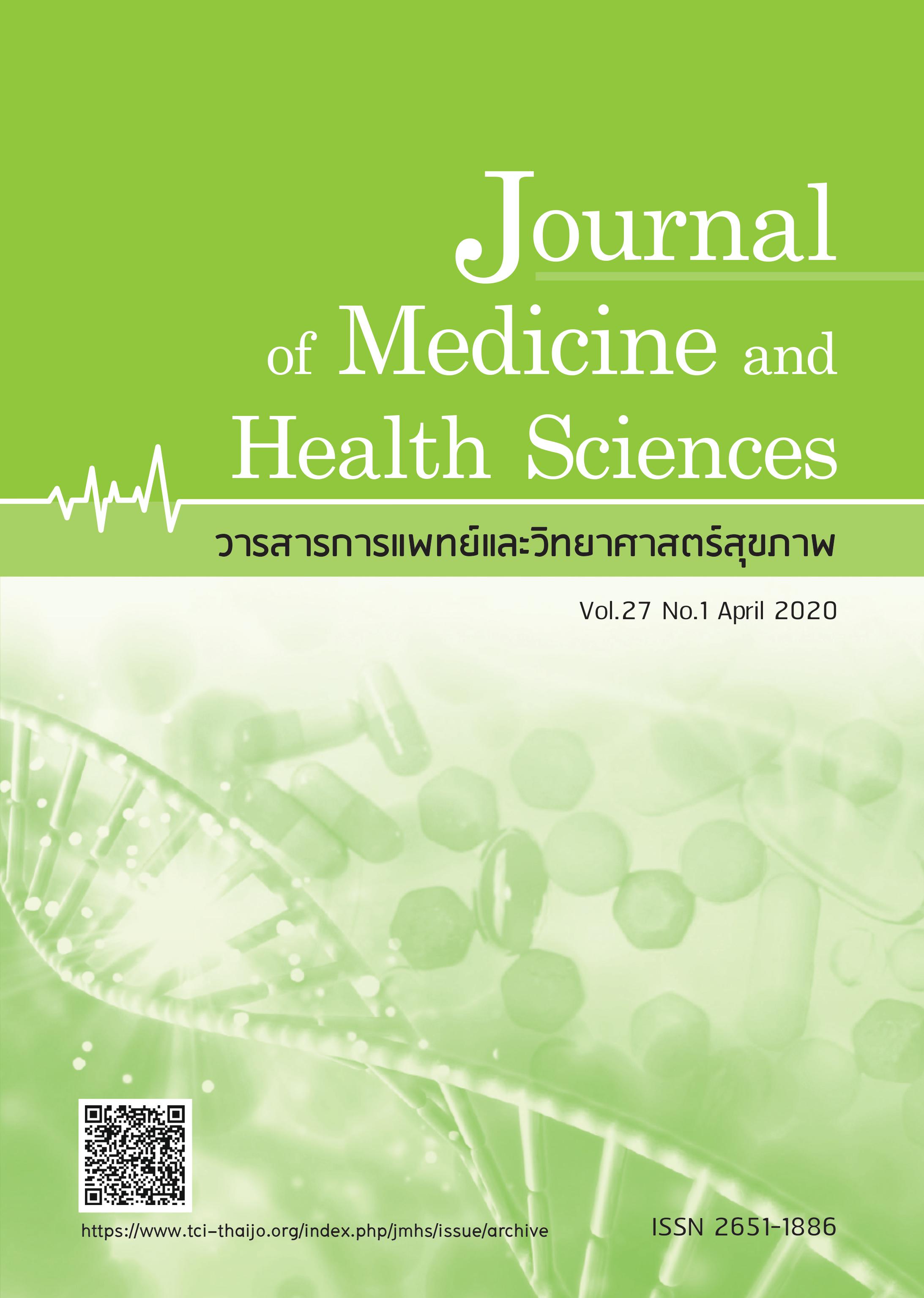Comparison of the effectiveness of topical 5% Centella Asiatica gel versus topical 1% clindamycin gel in the treatment of acne vulgaris
Keywords:
acne vulgaris, Centella asiatica extract, clindamycinAbstract
บทคัดย่อ
สิวถือเป็นโรคผิวหนังที่พบได้บ่อย ในผู้ป่วยที่มีอาการระดับน้อยถึงปานกลางมักจะใช้ยาทาในกลุ่มยาปฏิชีวนะ เช่น คลินดามัยซิน แต่ในผู้ป่วยบางรายเมื่อใช้ยาทาคลินดามัยซินในระยะยาวอาจเกิดการดื้อยาปฏิชีวนะ รวมถึงมีผลข้างเคียง เช่น อาการระคายเคือง ผิวแห้งลอก เป็นต้น จึงเป็นที่มาของการนำสารสกัดจากธรรมชาติมาใช้แทนยาปฏิชีวนะ สารสกัดจากใบบัวบก (Centella asiatica) มีฤทธิ์ต้านการอักเสบ ฆ่าเชื้อแบคทีเรีย Cutibacterium acnes (C.acnes) ลดการแบ่งตัวของ keratinocytes และมีฤทธิ์ช่วยสมานแผล จึงน่าจะนำมารักษาสิวได้ โดยงาน วิจัยนี้มีจุดมุ่งหมายเพื่อศึกษาผลของเจลสารสกัดใบบัวบกเทียบกับเจลคลินดามัยซินในการรักษาสิว ทำการศึกษาแบบ split-face, randomized, assessor-blind clinical trial ในอาสาสมัครที่มีอายุ 12-45 (27.85 ± 4.37) ปี ที่มีสิวระดับความรุนแรงน้อยถึงปานกลางจำนวน 30 คน โดยแบ่งซีกใบหน้าเป็นสองข้างและสุ่มเลือกให้ใบหน้าด้านหนึ่งทาเจลสารสกัดจากใบบัวบกและใบหน้าอีกด้านทาเจลคลินดามัยซิน ทาเฉพาะบริเวณที่เป็นสิว ทาเจลเช้าและเย็นติดตามผลการศึกษาโดยประเมินผลจากการนับจำนวนเม็ดสิว และคะแนนระดับความรุนแรงของสิว รวมถึงผลข้างเคียงที่เกิดขึ้นที่ระยะเวลา 1, 2, 4, 8 และ 12 สัปดาห์ และความพึงพอใจโดยรวมของอาสาสมัครต่อการรักษาเมื่อสิ้นสุดการวิจัย ผลการศึกษาพบว่า มีอาสาสมัครที่อยู่จนครบการวิจัยจำนวน 26 ราย ด้านที่ได้รับการรักษาด้วยเจลสารสกัดใบบัวบก 5% มีจำนวนสิวอักเสบในสัปดาห์ที่ 8 และ 12 น้อยกว่าอย่างมีนัยสำคัญทางสถิติ (p = 0.009 และ 0.040 ตามลำดับ) ค่าเฉลี่ยของจำนวนสิวไม่อักเสบของทั้งด้านที่รักษาด้วยเจลสารสกัดใบบัวบก 5% และด้านที่ได้รับเจล คลินดามัยซิน 1% ลดลงอย่างต่อเนื่องตามช่วงระยะติดตามผลโดยไม่มีความแตกต่างกันอย่างมีนัยสำคัญทางสถิตินอกจากนี้ ยังพบว่าคะแนนระดับความรุนแรงของสิวลดลงอย่างต่อเนื่องตามช่วงระยะติดตามผลทั้ง 2 ด้าน แต่ในสัปดาห์ที่ 8 ด้านที่รักษาด้วยเจลสารสกัดใบบัวบก 5% มีคะแนนระดับความรุนแรงของสิวน้อยกว่าอย่างมีนัยสำคัญทางสถิติ (p = 0.026) ในด้านความพึงพอใจโดยรวมของอาสาสมัครต่อการรักษาเมื่อสิ้นสุดการวิจัยของทั้งสองกลุ่มไม่แตกต่างกันโดยด้านที่รักษาด้วยเจลสารสกัดใบบัวบก 5% พบอาการข้างเคียงคือแสบร้อนในระดับน้อยมากเป็นระยะสั้นๆ หลังทายา ในขณะที่กลุ่มที่ได้รับเจลคลินดามัยซิน 1% ผิวหนังอักเสบมักมีอาการแสบร้อน คัน แห้ง และลอก จึงสรุปได้ว่าเจลสารสกัดใบบัวบก 5% มีประสิทธิภาพในการลดสิวอักเสบได้ดีกว่าเจลคลินดามัยซิน 1% ที่ระยะติดตามผล 8-12 สัปดาห์แต่มีความสามารถลดสิวไม่อักเสบได้เทียบเท่ากัน โดยเจลสารสกัดใบบัวบก 5% มีความปลอดภัยในการรักษาและพบอาการข้างเคียงน้อยกว่าเจลคลินดามัยซิน 1% ดังนั้น เจลสารสกัดใบบัวบก 5% จึงมีประสิทธิภาพและความปลอดภัยเหมาะสมที่จะนำมาใช้เป็นทางเลือกใหม่ในการรักษาสิวได้
Abstract
Acne is a common skin condition. Patients with mild to moderate acne can be treated with topical antibiotics such as clindamycin. In case patients who use topical antibiotics for a long time may lead to bacterial resistance, skin dryness and skin irritation. Centella asiatica extract has anti-inflammatory effect, bacteriostatic effect on Cutibacterium acnes (C.acnes), decrease follicular keratinocyte hyperproliferation and increase wound healing effect. Therefore, Centella asiatica may be useful to treat patients with acne vulgaris. To compare the efficacy of 5% Centella Asiatica gel versus 1% clindamycin gel, we enrolled 30 patients ages 12-45 (27.85 ± 4.37) with mild to moderate acne. In this prospective, split-face, randomized, assessor-blind clinical trial, patients were randomly allocated to receive either 5% centella gel or 1% clindamycin gel apply each side of face twice daily. The efficacy was evaluated by total number of inflammatory acnes and non-inflammatory acnes lesions, the global acne grading system scores (GAGS) and adverse effects at 1, 2, 4, 8 and 12 week of study and also patient’s satisfaction at the end of study. Twenty-six patients were able to complete the study. We found that the number of inflammatory acnes were lower on the side that treated with 5% centella gel in 8 and 12 weeks of study with statistically significant (p = 0.009 and 0.040 respectively). Non-inflammatory acnes in both sides decreased over time with no statistically significant between both sides. The GAGS scores also decreased continuously in both sides and GAGS scores were lower on the 5% centella gel side with statistically significant at 8 week of study (p = 0.026). Patient’s satisfaction between two group were similar. Adverse effects on the 5% centella gel side were minimal including burning sensation that limited to the period of application. Burning sensation, itching and skin dryness were reported in 1% clindamycin gel side. We conclude that 5% centella gel is more effective than 1% clindamycin gel in the treatment of mild to moderate acne vulgaris. 5% centella gel is safe and has only minor adverse effects. These results suggest that topical 5% Centella Asiatica can be used as alternative treatment for acnes.
References
2. Gollnick HP, Krautheim A. Topical treatment in acne: current status and future aspects.Dermatology 2003;206(1):29-36.
3. Walsh TR, Efthimiou J, Dréno B. Systematic review of antibiotic resistance in acne: an increasing topical and oral threat. Lancet Infect Dis 2016;16(3):e23-33.
4. Hashim P, Sidek H, Helan MH, et al. Triterpene composition and bioactivities of Centella asiatica. Molecules 2011;16(2):1310-22.
5. Sushma T, Sangeeta G, Gambhir IS. Centella asiatica: A concise drug review with probable clinical uses. J Stress Physiol Biochem 2011;7(1):38-44.
6. Won JH, Shin JS, Park HJ, et al. Antiinflammatory effects of madecassic acid via the suppression of NF-kappaB pathway in LPS-induced RAW 264.7 macrophage cells. Planta Med 2010;76(3):251-7.
7. Chomnawang MT, Surassmo S, Nukoolkarn VS, et al. W. Antimicrobial effects of Thai medicinal plants against acne-inducing bacteria. J Ethnopharmacol 2005;101(1-3):330-3.
8. Sampson JH, Raman A, Karlsen G, et al. In vitro keratinocyte antiproliferant effect of Centella asiatica extract and triterpenoid saponins. Phytomed 2001;8:230-5.
9. Wu F, Bian D, Xia Y, et al. Identification of major active ingredients responsible for burn wound healing of Centella asiatica herbs. Evid Based Complement Alternat Med 2012;2012:848093 Doi:10.1155/2012/848093.
10. Bechaux S, Egasse-broca I, Filbet M, et al. Study of the benefit of Cytolac®, a moisturising cream formulated with Centella Asiatica, used as a monotherapy to treat the retentional, inflammatory and scarring lesions caused by moderate acne. Nouvelles Dermatologiques 2006;25:671-4.
11. Doshi A, Zaheer A, Stiller MJ. A comparison of current acne grading systems and proposal of a novel system. Int J Dermatol 1997;36(6):416-8.
12. Shahmoradi Z, Iraji F, Siadat AH, et al. Comparison of topical 5% nicotinamid gel versus 2% clindamycin gel in the treatment of the mild-moderate acne vulgaris: A double-blinded randomized clinical trial.J Res Med Sci 2013;18(2):115-7.
13. Zaenglein AL, Pathy AL, Schlosser BJ, et al. Guidelines of care for the management of acne vulgaris. J Am Acad Dermatol 2016;74(5):945-73.
14. Kurokawa I, Nishijima S, Kawabata S. Antimicrobial susceptibility of Propionibacterium acnes isolated from acne vulgaris. Eur J Dermatol 1999;9(1):25-8.
15. Krautheim A, Gollnick HPM. Acne: Topical treatment. Clin Dermatol 2004;22:398-407.
16. Pojanaukij N, Kajorncheappunngam S. Comparison of antimicrobial activity of Mangosteen crude, Turmeric and Gotu Kola extract. NUJST 2010;18(1):1-9.
17. Ratz-Łyko A, Arct J, Pytkowska K. Moisturizing and Antiinflammatory Properties of Cosmetic Formulations Containing Centella asiatica Extract. Indian J Pharm Sci 2016;78(1):27-33.
18. Morisset R, Côté NG, Panisset JC, et al. Evaluation of the healing activity of hydrocotyle tincture in the treatment of wounds. Phytother Res 1987;1(3):117.



